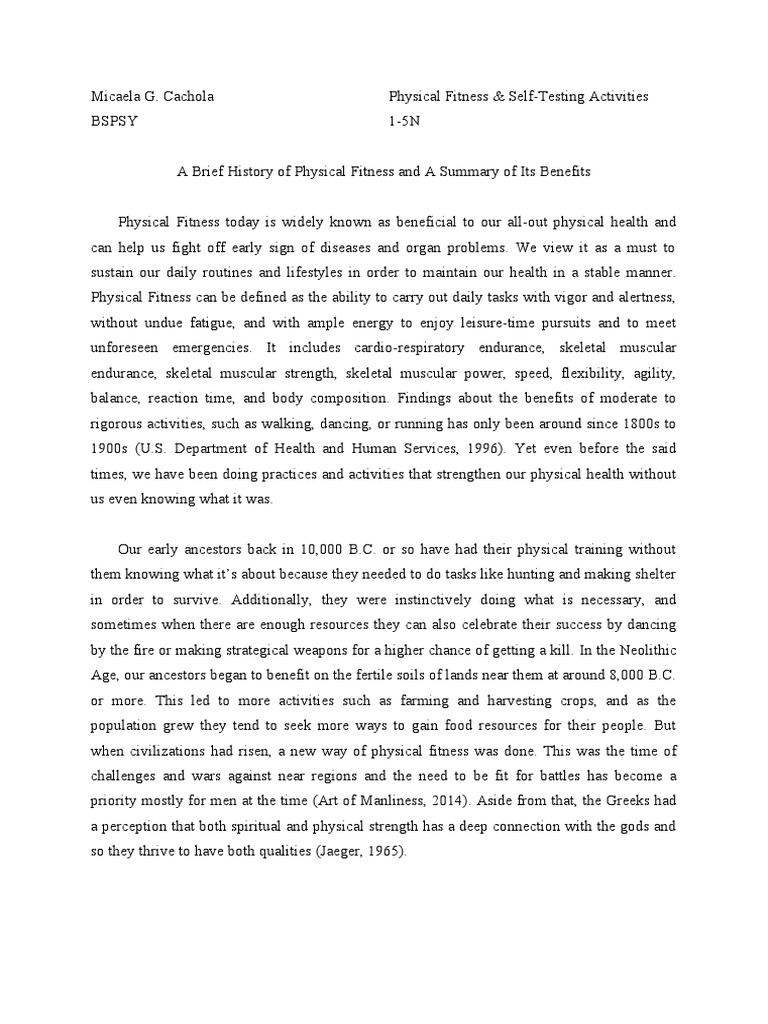The discourse surrounding physical fitness and human vitality is not merely a modern phenomenon; rather, it is deeply entrenched in the annals of human history. This article embarks on a journey through time to elucidate the evolution of physical fitness practices, underscoring the intricate relationship between physical exertion, health, and societal norms. Through an examination of ancient civilizations, the Renaissance, and modernity, we will unveil the multifaceted reasons for humanity’s enduring preoccupation with physical well-being.
1. Antediluvian Epoch: The Roots of Physical Engagement
The nascent chapters of human history reveal that physical fitness was not an abstract concept but rather a necessity for survival. Early Homo sapiens engaged in rigorous activities such as hunting, foraging, and various forms of locomotion which mandated not only stamina but also strength. These primal endeavors for subsistence sculpted a society that inherently valued physical prowess. Anthropological studies illuminate how these early engagements fostered a profound connection between an individual’s physical capabilities and their social standing.
2. Ancient Civilizations: The Codification of Fitness
As humanity progressed, the ancient Greeks emerged as pivotal figures in the development of physical fitness philosophy. The concept of “arete,” or excellence, encompassed not just intellectual prowess but also physical vitality. The Greeks institutionalized fitness through the establishment of the Olympic Games, which were predicated on rigorous training and competition. Noteworthy is the Greek belief in the symbiotic relationship between body and soul, encapsulated in the philosophy of “a sound mind in a sound body.”
Simultaneously, ancient societies such as the Egyptians and Mesopotamians exhibited a burgeoning awareness of physical health. Their cultures integrated physical training into military preparation, recognizing that a robust populace was essential for the defense and prosperity of the state. Pictorial art and hieroglyphics reflect a reverence for strength, agility, and endurance—qualities commanded by the elite.
3. The Middle Ages: A Shift in Paradigms
The Middle Ages ushered in a contrasting perspective on fitness, significantly influenced by the prevalent theological ideologies. Physical fitness waned in prominence as asceticism became a virtue in the Christian doctrine. The body was often viewed as a vessel of sin, necessitating neglect in favor of spiritual pursuits. However, the emergence of knightly culture heralded a resurgence in the valorization of martial prowess, giving rise to tournaments and chivalric codes that celebrated physicality.
Moreover, the societal need for military readiness prompted a rekindling of physical training. This period, oscillating between neglect and celebration of the corporeal form, laid the groundwork for the evolving attitudes toward fitness in the forthcoming centuries, cloaked in a burgeoning acknowledgment of physical health as integral to societal strength.
4. The Renaissance: Reclamation of the Body
The Renaissance, a harbinger of humanistic ideals, encapsulated a renewed appreciation for the corporeal form. This epoch witnessed a flourishing of arts and sciences, which inevitably intersected with concepts of physicality. Leonardo da Vinci’s anatomical studies and depictions of the human form reflect an intricate understanding of bodily mechanics, signifying a shift toward embracing physicality as a source of beauty and vitality.
Furthermore, Pedro de Campolargo’s treatises on human anatomy and Leon Baptista Alberti’s advocacy for athletic pursuits reinforced the belief in the potential for improvement through physical training. This period marked a pivotal transition, as physical fitness emerged not solely as a means of survival or military preparation but as a pivotal component of personal development and self-expression. Such philosophical underpinnings would catalyze subsequent generations’ approach to fitness and health.
5. The Industrial Revolution: A Paradigm Shift
The advent of the Industrial Revolution precipitated profound changes in lifestyle and labor. While mechanization enhanced productivity, it also engendered a sedentary populace, catalyzing concerns over public health and vitality. In response, various physical culture movements emerged during the 19th century, championing health through exercise and recreation. Figures such as Friedrich Ludwig Jahn in Germany and the establishment of the Gymnastic Movement heralded a deliberate effort to counteract the adverse effects of industrialization.
Across the Atlantic, the burgeoning embrace of physical education within academic institutions underscored the necessity of fitness in a rapidly modernizing society. The establishment of organized sports became a cornerstone in the quest for physical improvement, cultivating a collective consciousness that pervades contemporary views on fitness.
6. The 20th Century: A Cultural Renaissance of Fitness
The 20th century marked an unparalleled fixation on physical fitness and its ramifications for health, well-being, and identity. The post-World War II era heralded the emergence of fitness as a lifestyle choice, characterized by a surge in commercial gyms, aerobics classes, and the popularization of running as a form of self-improvement. This decade saw the birth of fitness icons and the proliferation of health-related philosophies underscored by scientific research on the benefits of regular physical activity.
Moreover, societal shifts towards wellness—spurred by a burgeoning consumer culture—signified a monumental reconfiguration of perceptions regarding health and athleticism. The diverse array of fitness modalities now accessible to individuals—from yoga to high-intensity interval training—reflects a heightened consciousness of the paramount importance of physical vitality in achieving holistic well-being.
7. Modernity: An Ever-Evolving Landscape
Today, the dialogue surrounding physical fitness remains fervent and evolving, imbued with technology, social media, and an overwhelming array of fitness trends. Yet, the core fascination with physical fitness transcends these modern innovations. It points towards an intrinsic human desire for mastery over one’s body, a quest for longevity, and an understanding of the body as an instrument through which human potential unfolds.
In examining the intricate tapestry woven throughout history, it is evident that the pursuit of physical fitness is not merely a trend but an indelible aspect of the human experience. It reflects our continuous quest for vitality, resilience, and the quintessential nature of human existence.
